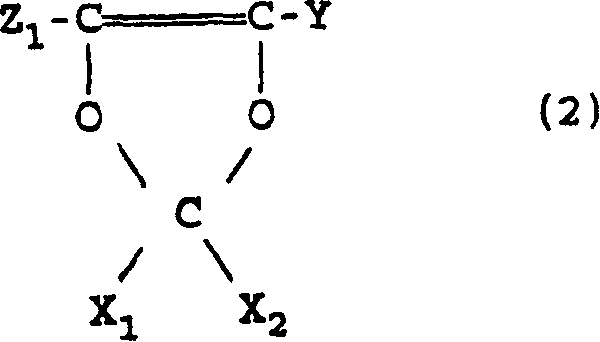Perfluoroelastomers
A perfluoroelastomer and elastomer technology, applied in the field of perfluoroelastomers, can solve problems such as unimproved mechanical properties, and achieve the effect of improving mechanical and compression set properties
- Summary
- Abstract
- Description
- Claims
- Application Information
AI Technical Summary
Problems solved by technology
Method used
Image
Examples
Embodiment
[0183] Analytical method
[0184] Determination of polymer Tg
[0185] Tg is determined by DSC analysis according to ASTM D 3418 method. Tg values reported in the examples are midpoint Tg.
[0186] Determination of intrinsic viscosity
[0187] Intrinsic viscosity was measured in perfluoroheptane at a temperature of 30°C.
[0188] -COF Determination of polar end groups
[0189] At the end of the polymerization, the polymer was isolated from coagulation by freezing at -20° C. and subsequently defrosting at room temperature until a slurry was obtained in which the polymer settled at the bottom; it was washed twice with demineralized water and heated in an oven at 90 Dry at °C until constant weight (approximately 12 hours); by using Nicolet Nexus FT-IR equipment (256 scans, resolution 2cm -1 )-COF end groups determined by FT-IR spectroscopy, where first 4000 cm -1 and 400cm -1 between scans, the film was then kept for 12 hours in an environment saturated with a...
Embodiment A
[0199] Preparation of CF in a glass reactor by thermal reaction at 170 °C 3 OCOF
[0200] A tubular glass reactor with an internal diameter of 55.6 mm, a length of 510 mm, filled with 6x6 glass Raschig rings (free internal volume 842 ml), thermostatted by an electric resistance was used.
[0201] Simultaneously the CF synthesized as described in USP 4400872 3 OF flow (1.5 L / h) and CO flow (1.5 L / h) were fed into the reactor maintained at 170°C for 5 hours. The stream from the reactor was continuously analyzed by on-line gas chromatographic analysis.
[0202] The stream from the reactor except CO was condensed in a trap kept at -110 °C containing 15 g CFCl=CFCl (A 1112) such that residual CF 3 Reaction of OF with alkenes to give CF 3 OCFClCF 2 Cl.
[0203] After fractional distillation of the resulting mixture, 33.9 g of 99.8% pure CF were obtained 3 OCOF (for feed CF 3 The molar yield of OF 76.5%), the CF of 12.3g 3 OCFClCF 2 Cl, 3.4 g COF 2 .
[0204] relative fee...
Embodiment B
[0206]Preparation of CF in a PTFE reactor by thermal reaction at 170 °C 3 OCOF
[0207] A PTFE tubular thermostatic reactor with an inner diameter of 4 mm and a length of 13.2 m was used.
[0208] CF 3 OF gas flow (1.5 liters / hour) and CO flow (2.0 liters / hour) were fed into the reactor maintained at 170°C.
[0209] The stream from the reactor was analyzed by gas chromatography to have the following molar composition: 7.3% CF 3 OF, 54.2% CF 3 OCOF, 9.1% COF 2 and 29.4% CO.
PUM
| Property | Measurement | Unit |
|---|---|---|
| The inside diameter of | aaaaa | aaaaa |
| The inside diameter of | aaaaa | aaaaa |
| Length | aaaaa | aaaaa |
Abstract
Description
Claims
Application Information
 Login to View More
Login to View More - R&D
- Intellectual Property
- Life Sciences
- Materials
- Tech Scout
- Unparalleled Data Quality
- Higher Quality Content
- 60% Fewer Hallucinations
Browse by: Latest US Patents, China's latest patents, Technical Efficacy Thesaurus, Application Domain, Technology Topic, Popular Technical Reports.
© 2025 PatSnap. All rights reserved.Legal|Privacy policy|Modern Slavery Act Transparency Statement|Sitemap|About US| Contact US: help@patsnap.com



